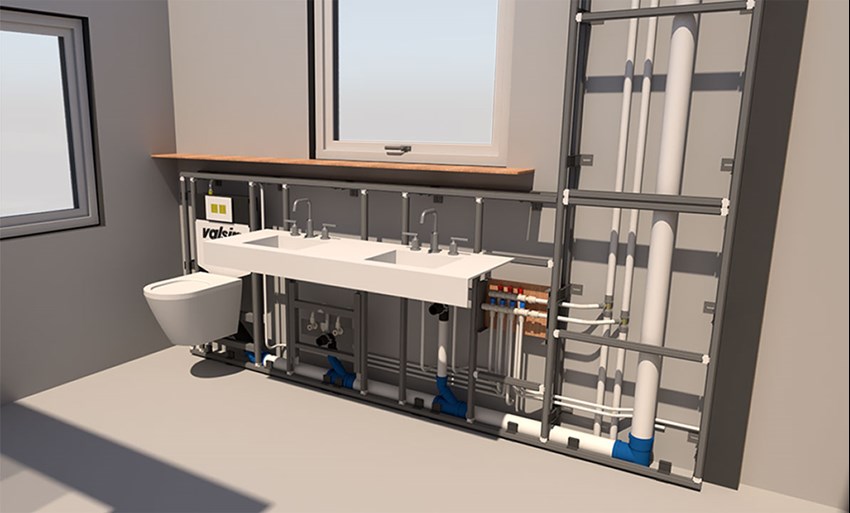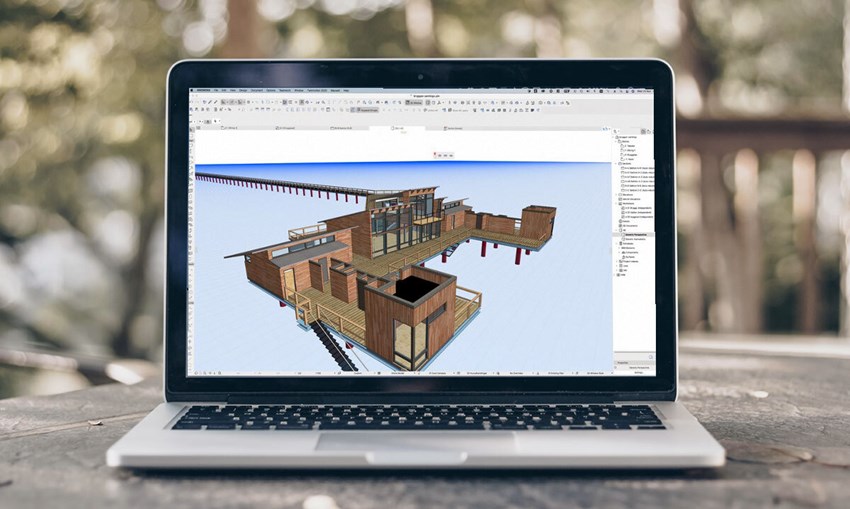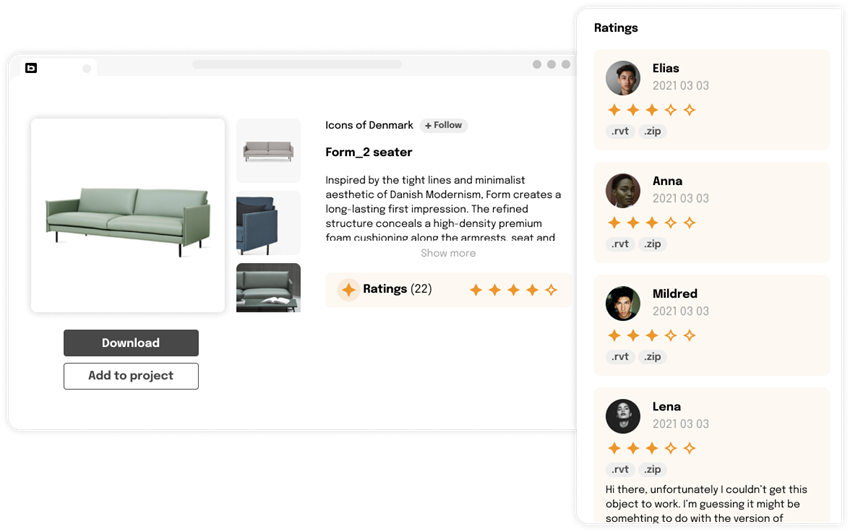2025 tradeshow highlights: BIMobject year-in-review
Discover key BIM trends from BIMobject’s 2025 event year insights from global tradeshows, digital workflows, sustainability talks, and manufacturer adoption.
Want to get your products into more digital projects? This 10-minute read gives you must-know tips on refining your BIM objects, increasing your brand's attractiveness in the eyes of designers, and taking your BIM content strategy to the next level.

The goal of BIM object creation is to accurately showcase a product's unique features and benefits to AEC (architecture, engineering & construction) professionals. Starting with graphical information, the creation of BIM objects requires the incorporation of critical product data such as:
But what makes a BIM object good? Well, it depends on your product type and its level of complexity. The information needed for a chair isn't the same as that of a door. The general rule of thumb, however, is that a BIM object should visually reflect the real-world physical product and function accordingly.
3D geometry is important for smooth spacial coordination. But the most important aspect of a BIM object is that it contains the data needed for architects and engineers to validate the product's fit in the project. For example:

As a manufacturer, you've put a lot of time into developing and fine-tuning your products. So naturally, you want your physical products' digital versions to look as true to form as possible. Right?
Unfortunately, that might not be the best tactic to adopt if you want to get your BIM objects downloaded and used in BIM projects.
Getting too nitty-gritty with the details or including all product features will create a file that's too large or contains redundant information. If you want to offer BIM objects architects and engineers will love to use; don't create them for vanity – create them for use. Put product information, materials, and textures first – factors that make a huge difference when architects or engineers sell a project preview to a client.
Building standards and regulations vary around the globe, and AEC professionals must adhere to them when designing. It’s worth noting that there are more standards floating about in the world than one can count on both hands. So, your BIM content should reflect the regionally applicable standards and regulations for your target countries.
The goal of creating BIM objects is to get products downloaded, used, and specified in digital building projects. But that won’t happen unless your BIM objects can be used in the right BIM software systems. The tricky thing is:
1. There are multiple BIM software available.
2. These software systems are used by various industry segments.
3. And the systems used by various segments can sometimes even be used in different phases of the construction process.

So, how can manufacturers make the wisest investment in the systems concoction? Boring answer: it depends on what products you offer and your goals. Broadly speaking: Revit and Archicad are your safest bet for maximum compatibility, likeability, and downloads. Marta Gutiérrez, Architect and BIM consultant at BIMobject, says in a recent interview on BIM content development:
Broadly speaking, Archicad is a visual and versatile software that leans more toward the architectural side. Historically, Revit has earned a following from both engineers and architects by offering more solutions catered to HVAC, MEP, and structural engineering – giving electrical and HVAC products developed in Revit a leg up. However, it's worth noting that the gap's narrowing between the two software systems.
Another important thing to know is that AEC firms that work with Revit rarely work with Archicad – and vice versa. That brings us to the next point:
Developing BIM content in both Archicad and Revit is key to getting maximal love from architects and engineers. Why? Simply because you’re covering a larger number of professionals who can use your BIM objects in their software.
However… BIM content development isn’t free. If you’re running a bit low on budget, we’d recommend investing in the most popular and used system: Revit.
BIM is all about the accessibility and interoperability of information. So, if you want to make specifiers love your BIM content, you need to make it easily accessible and available.
As a manufacturer, you can choose a wild mix of owned, paid, and earned marketing tactics. Or – take the path of least resistance by getting on a BIM object marketplace filled to the brim with professionals within the building industry.
The power of a BIM object marketplace boils down to purpose and intent. Users on BIM marketplaces come from all professional walks of life, ranging from architecture, engineering, construction, and interior design.
Now, they don't visit BIM libraries or marketplaces to find a recipe for cake or check up on auntie Ann. They're there with the purpose of getting inspired and the intent to download products and use them in projects. Having your brand and products present on BIM marketplaces enables you to connect with professionals who are open to your messaging, educated, and willing to listen to what you have to say.
Find out what our marketplace for BIM objects and building product data can offer you >
Don’t treat your BIM object downloads like a done-and-dusted deal. Although a whopping 83% of users intend to specify when downloading from bimobject.com, you might want to offer support along the way to stay top of mind, get transferred from the library to the model, and ultimately move from supplier to collaborative partner.
Ariston, the global specialist in water heating and heating, makes support a main point in their BIM object marketing. The manufacturing company recently started using BIMobject Email campaigns to stay closer to AEC professionals by providing on-field support and promoting online tools for technical documentation and general information. Lorenzo Sileoni, Ariston’s Application Solutions Senior Manager in Europe, adds:
"At Ariston, we use Email campaigns weekly as specifiers may need short-term support in regard to our BIM objects."
 Read Ariston’s experience using BIMobject’s Email campaigns tool >
Read Ariston’s experience using BIMobject’s Email campaigns tool >
BIM objects play a crucial role in BIM. By developing them, you’re essentially providing the necessary information for a comprehensive virtual building and ensuring that the information used in the model is both accurate and up-to-date.
But let’s harp on the latter part for a moment. Or two. New software versions, URL changes, and new product updates impact your file’s compatibility and accuracy. Ultimately, this may harm your reputation – and trustworthiness in the eyes of architects, engineers, and interior designers. Your BIM content isn’t always as fresh as a daisy – but you should aim to keep it that way with regular BIM content maintenance.
Want your BIM content fresh and updated 24/7 365? Our hassle-free content maintenance subscription service will keep it that way.
You want to create a high-value BIM object offering to build better relationships and get specified in more projects. But that requires a two-way road of communication. Asking for feedback on your BIM content leads to improvements, unveiling new areas of potential innovation, and finding out what your target audiences like.
We’ve made the process easier by allowing architects and engineers on bimobject.com to rate BIM files downloaded – the average rating being an impressive 4.2 out of 5. Although this might seem daunting, it gives manufacturers a direct feedback loop, alerts you to take immediate action on low scores, and grants your brand greater credibility through social proofing.

Feedback, availability, and 3D aside: the real win kicks off as soon as you develop BIM content. The sheer offering of digital versions of your physical products showcases that you're an attentive and service-minded provider of building products. But we get it: navigating through the brave new world of BIM can feel a bit daunting. Luckily, we can make the process run a bit smoother for you.
Discover key BIM trends from BIMobject’s 2025 event year insights from global tradeshows, digital workflows, sustainability talks, and manufacturer adoption.
See how architects and engineers find products and what information they trust. Use these insights to shape your 2026 marketing plan.
Learn how BIM influences product selection and what makes specifiers choose one brand over another. Insights from BIMobject’s expert interview.